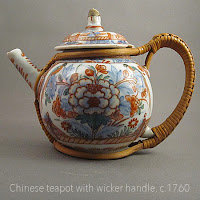This porcelain teapot was
made in China, c.1750-1770, where it was decorated with flowers and leaves in
blue under glaze. Apparently, soon after it was exported to the Netherlands, with
simple blue and white decoration fell out of favour, and more colourful designs
were the new trend. To satisfy the demand, it seems that this teapot was
overpainted in red, green, black, and gold enamels. Amsterdams
Bont (colourful Amsterdam work) is the term used to describe this form
of decoration. Ceramics overpainted in England are referred to as being clobbered. This
teapot measures 4.75 inches high, 6.5 inches from handle to spout.
This
teapot has an woven wickery replacement handle and straps and apparently there
are few entirely woven repairs/replacements around. This one was most likely done
by a basket maker rather than a tinker or a jeweller. However, some European silversmiths
used wickery handles over silver to insulate the handle.
This teapot was most
likely repaired in an urban city where silversmiths produced this class of work
that typically used woven rattan cane for insulation. Such ‘wickery makers’
would have worked in close association with a network producers in various fields
in both Europe and North America.
Somewhat curiously, wherever this ‘handling’ appears to take place it seems that ‘rattan cane’ is the material used.
Somewhat curiously, wherever this ‘handling’ appears to take place it seems that ‘rattan cane’ is the material used.
Wickery handles in similar contexts















No comments:
Post a Comment